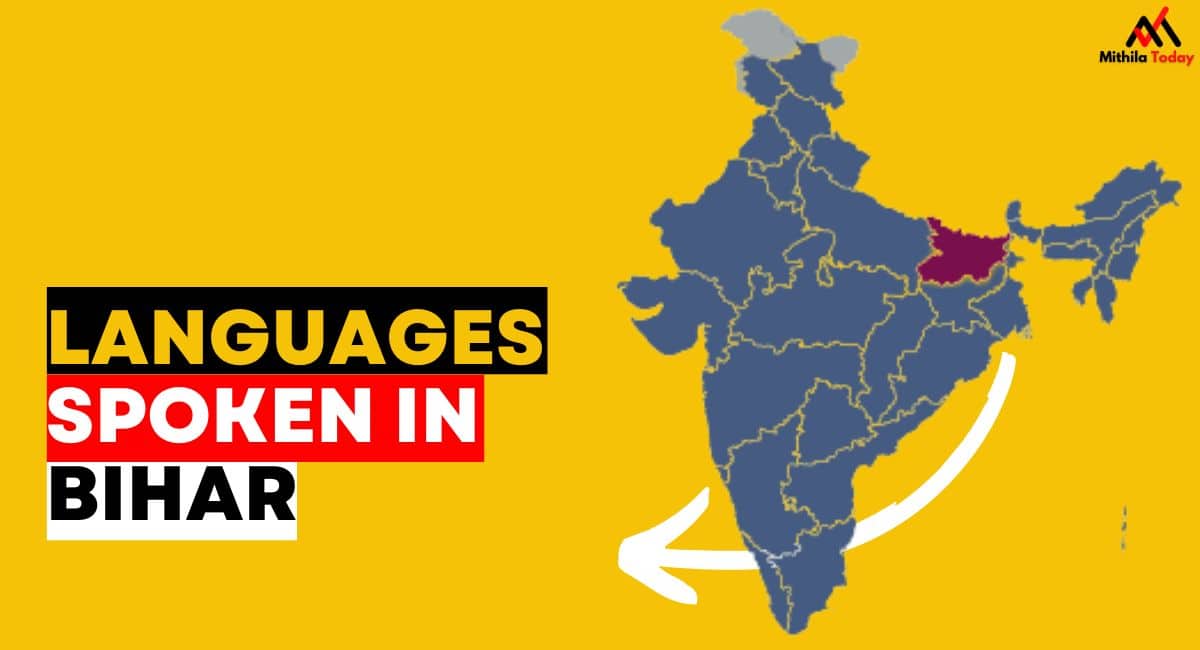Bihar, the historical heartland of India, is a treasure trove of linguistic diversity that weaves a rich cultural tapestry. The languages spoken in this region are not merely modes of communication; they are vessels that carry the wisdom of generations, the echoes of ancient civilizations, and the nuances of daily life.
The official language of the state is Modern Standard Hindi, but there are five other languages spoken in the region. Foremost among these languages is Bhojpuri, spoken in the western regions of the state. Maithili thrives in the northern territories, while Magahi flourishes in the central areas, particularly around the capital city of Patna and in the southern regions.
Maithili holds the esteemed status of official recognition under the Eighth Schedule to the Constitution of India. Bihar is the only state where a total of 5 languages are spoken these languages are:
- Angika
- Bhojpuri
- Magahi
- Maithili
- Vajjika (Bajjika)
Bihar, with its linguistic diversity and rich cultural heritage, continues to be a unique and vibrant tapestry of India’s history and traditions. These languages are not just words; they are living testaments to the enduring spirit of the people of Bihar. Let’s explore them one by one:
Angika
- Origin: Anga kingdom (around 800 BCE)
- Speakers: Around 30 million
- Script: Bengali
- Cultural Role: Carries the legacy of the Anga kingdom, showcasing the region’s rich history.
Angika, stemming from the ancient Anga kingdom, is a language spoken by around 30 million people. As it flows from the lips of its speakers, it keeps alive the legacy of a kingdom that once shaped the region. Through Angika, the tales of Anga’s rise and fall, its people, and their customs, continue to resonate in modern Bihar.
Bhojpuri
- Origin: Magadha kingdom
- Speakers: Over 180 million (India and Nepal)
- Script: Devanagari
- Cultural Role: Transcends borders, connecting people across regions through songs, poetry, and literature.
Bhojpuri, the voice of over 180 million individuals in India and Nepal, transcends geographical boundaries. Originating from the Magadha kingdom, it holds within its syllables stories of migration, cultural diffusion, and shared experiences. Bhojpuri, through its folk songs, poetry, and literature, binds together people from distant corners, forging connections that echo with historical significance.
Magahi
- Origin: Magadha kingdom (around 500 BCE)
- Speakers: About 20 million
- Script: Devanagari
- Cultural Role: Holds the stories of Magadha’s rise and fall, adding layers to Bihar’s cultural mosaic.
Magahi, spoken by about 20 million people, finds its roots intertwined with the Magadha kingdom. This language, too, contributes to Bihar’s cultural mosaic, serving as a vessel for the tales of the region’s past glories and enduring spirit. The lyrical beauty of Magahi poetry, the resonance of its proverbs, and the cadence of its speech all add layers to Bihar’s vibrant cultural narrative.
Maithili
- Origin: Mithila kingdom
- Speakers: Approximately 18 million
- Script: Devanagari
- Cultural Role: Carries the tales of the ancient Mithila kingdom, celebrating traditions and folk art.
The language of Maithili carries the whispers of the ancient Mithila kingdom, echoing through time. With around 18 million speakers, it paints a vivid picture of a kingdom that once thrived along the border of modern Bihar and Nepal. Maithili, in its various forms, celebrates the traditions, rituals, and folk art that have sustained communities over centuries.
Vajjika
- Origin: Vajji kingdom (around 700 BCE)
- Speakers: Roughly 1 million
- Script: Devanagari
- Cultural Role: Reflects the resilience of cultures and languages over time.
Vajjika, a language spoken by approximately 1 million people, is a tribute to the Vajji kingdom’s enduring legacy. Amidst the changing tides of history, Vajjika stands as a testament to the resilience of cultures and languages. Its small yet resilient community carries forward the torch of its ancestors, preserving an invaluable piece of Bihar’s heritage.
Voices of Heritage
Collectively, these languages transform Bihar into a linguistic kaleidoscope, showcasing the myriad ways human expression has evolved and flourished in the region. They breathe life into rituals, folklore, and customs, bridging the gap between past and present. As generations evolve and technology reshapes the world, these languages continue to be the threads connecting Bihar’s people to their roots.
In the heart of Bihar’s bustling cities and tranquil villages, amid the buzz of modernity and the echoes of history, the languages of Angika, Bhojpuri, Magahi, Maithili, and Vajjika stand as enduring guardians of the state’s cultural heritage. Through them, Bihar’s past remains alive, its present is enriched, and its future is deeply rooted in the legacies of those who came before.
FAQs
The main languages spoken in Bihar are Maithili, Hindi, Urdu, Bhojpuri, Magahi, Vajjika (Bajjika), and Angika.
Yes, English is spoken alongside the regional languages in Bihar.
No, Bhojpuri is not the official language of Bihar. Hindi is the official language.
Hindi is the most widely spoken language in Bihar.
No, Maithili is not the official language of Bihar. It is one of the regional languages spoken in the region.
The mother tongue of Bihar is Hindi.
Yes, Urdu and Hindi are mutually intelligible, as both are derived from Sanskrit.
Yes, Magahi is an Eastern Indo-Aryan language.
The Angika language is believed to have originated from a mix of Maithili and Bhojpuri.
Yes, the Hindi spoken in Bihar has some unique dialectical features and pronunciation that differ from Hindi spoken in other parts of India.
Hindi holds immense significance in Bihar, being the official language of the state. It is spoken and understood by a large majority of the population. Hindi is the language of administration, education, and media in Bihar. It serves as a common medium for communication across different communities and regions in the state.
Bhojpuri is another major language spoken in Bihar. It belongs to the Indo-Aryan language family and is predominantly spoken in the eastern part of the state. Bhojpuri has a rich literary tradition and cultural significance. It is widely spoken not only in Bihar but also in neighboring states like Uttar Pradesh and Jharkhand.
Urdu, a language with Persian and Arabic influences, holds a significant place in the linguistic landscape of Bihar. Although not an official language, Urdu is widely spoken and understood by a considerable number of people in the state. It has a rich literary tradition and has contributed to the cultural heritage of Bihar.
Maithili, an Indo-Aryan language, is the second official language in Bihar. It is spoken by a large population in the state, particularly in the northern regions. Maithili has a rich cultural heritage and a distinct linguistic identity. It has been recognized as one of the major languages of Bihar.
Urdu is not spoken as a distinct dialect in Bihar, but it has influenced the local dialects of Hindi spoken in the state. It has contributed words, phrases, and expressions to the spoken language of Bihar, reflecting the historical connection between Bihar and Urdu.
Bihar has shared historical and cultural ties with Urdu. The language flourished under the patronage of the Mughal rulers, who had a significant influence in Bihar. Urdu poetry, literature, and music have thrived in Bihar, making it an important center of Urdu culture in northern India.
Magahi, an Indo-Aryan language, is spoken in the southern part of Bihar. It has a distinct linguistic identity and is recognized as one of the major languages of the state. Magahi has contributed significantly to the cultural heritage of Bihar, with its rich folk traditions, literature, and music.
Angika is another language spoken in Bihar, primarily in the districts of Bhagalpur and Munger. It belongs to the Bihari language group and has its own unique characteristics. Angika adds to the linguistic diversity of Bihar, reflecting the cultural and regional variations within the state.
Yes, apart from the mentioned languages, there are several other Indo-Aryan languages spoken in Bihar. These include languages such as Magadhi, Bajjika, and Kurmali. Each of these languages has its own distinct features, dialects, and contribution to the linguistic landscape of Bihar.
The term “Bihari” is often misunderstood as a language, but it is actually a regional identity associated with the people of Bihar. Bihar is known for its linguistic diversity, and the term “Bihari” encompasses the various languages and dialects spoken in the state, including Hindi, Bhojpuri, Maithili, Magahi, Angika, and others.
The linguistic diversity of Bihar is an integral part of its cultural heritage. The various languages spoken in Bihar have shaped its literature, art, music, and traditions. They have given rise to a vibrant cultural mosaic, where each language and dialect contributes to the overall identity of Bihar.


